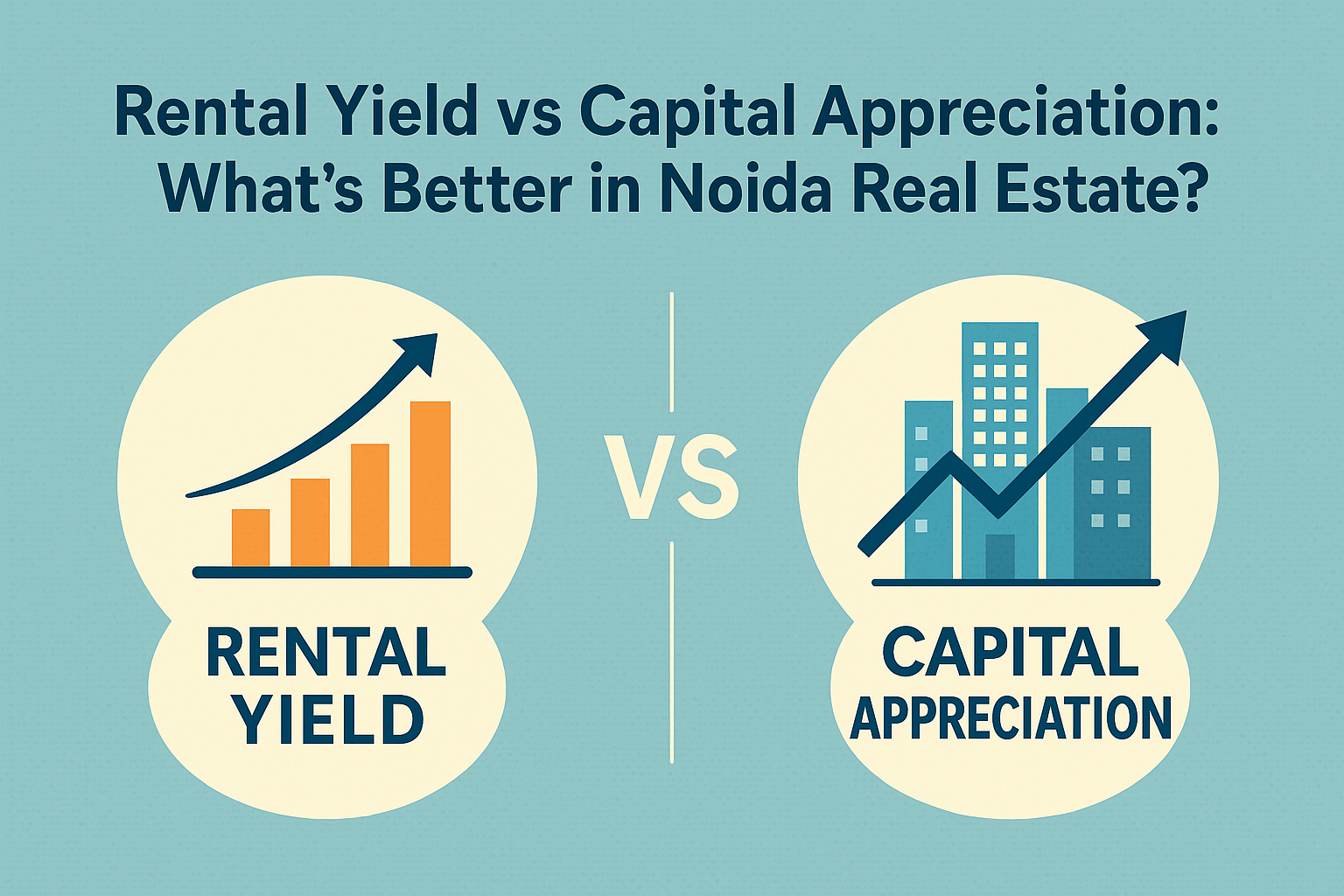Introduction
When discussing real estate investment, two crucial terms frequently come up: rental yield and capital appreciation. These concepts are essential components of returns on property investments. Therefore, before making any significant investment decision in real estate, it’s important to conduct a thorough study of both concepts to ensure that your investment goals align accordingly.
Rental Yield and Capital Appreciation:
To make an investment decision, let’s first understand what rental yield and capital appreciation are.
Rental Yield – Rental yield is the annual rental income generated from a property put into rent, and it is denoted as a percentage of that property’s market value. Rental yield is an ideal investment option for individuals seeking a consistent cash flow and a steady source of income. Rental yield significantly determines the maximum income-generating potential of a real estate property.
Rental Yield can be calculated as –
RY(%) = (Annual Rental Income / Property’s Market Value) x 100%
For example, if a property’s market value is Rs 80,00,000 and it is put on rent at Rs 18,000 per month, annual income being Rs 2,16,000, then,
RY = (2,16,000/80,00,000) x 100% = 2.7%
A higher rental yield indicates a greater return on investment, making it a significant component of real estate investment.
Capital Appreciation – On the other hand, capital appreciation refers to the consistent increase in the property value over a while beyond its base purchase price. Capital appreciation is influenced by various other factors such as location, low interest rates, economic growth, external developments, demand-supply dynamics, and overall market trends.
Capital Appreciation (%) = (Current market value of the property – The original (base) purchase price) / Purchase price x 100%
For example, if a property was bought at Rs 60,00,000 and its market value appreciates to Rs 80,00,000 over 2-3 years, then,
Capital Appreciation (%) (absolute) = (80,00,000 – 60,00,000) / 60,00,000 x 100% = 33%
Both these investment components yield an overall return, but their rate of return often depends upon the property type, location, market conditions, and investment horizon.
Noida’s Real Estate Journey:
Noida has transformed from an industrial township into a modern urban city, marking an incredible transition over the years. Its development has attracted a large population of investors, working professionals, and homebuyers due to its well-planned infrastructure, good connectivity, and strong job market. Enhanced facilities, including top schools, hospitals, IT companies, and shopping hubs, have made Noida a comprehensive living destination. Furthermore, the government’s ongoing efforts to develop expressways, expand metro lines, and establish an international airport at Jewar have significantly increased the area’s attractiveness, positively affecting property values throughout Noida.
- Rental Yield in Noida – Noida’s rapid urbanization, emerging as an employment hub—primarily in the IT and manufacturing sectors—and improved infrastructure have made it appealing to both working professionals and students. The growing demand for rental homes near business and industrial hubs ensures a steady income stream for property owners. Key factors driving rental yields in Noida include:
- Improved connectivity, including the expansion of metro lines to major zones and major expressways like the Noida-Greater Noida Expressway and the Yamuna Expressway.
- Availability of affordable housing compared to Delhi and Gurugram.
- The establishment of IT hubs, multinational corporations (MNCs), and startups, mainly in sectors 62, 63, and 135, is boosting demand for rental housing.
- The presence of prestigious educational institutions like Amity University and Sharda University has increased rental demand from students, faculty, and staff in nearby areas.
Some prime locations for rental yield in Noida include:
- Sector 76, 77, and 78 – approx 2% – 3.2% (mid-range sectors with a large number of residential apartments that are ideal for families with proximity to metro lines, schools, hospitals, etc).
- Greater Noida West (Noida Extension) – approx 3.5% (affordable residential options that are good for beginner-level investors with good appreciation potential)
- Sector 150 – approx 3% (a risky investment option that was planned to be a sports city with low-density premium residences, mostly preferred by NRIs and the executive class).
- Sector 62 – approx 2%, and affordable (one of the oldest established sectors of Noida, with great metro connectivity and corporate offices that drive good rental demand).
- Sector 135 – approx 4% (highly demanded sector along the Noida – Greater Noida Expressway for rental homes by IT professionals because of some major commercial hubs like Genpact, Candor Techspace, Assotech Business Cresterra, etc).
- Sector 46 – approx 4%, affordable and high rental yield (Proximity to the Noida – Greater Noida Expressway and excellent connectivity via main roads and metro lines to major commercial hubs and business centers fuels rental demand).
To achieve a good rental yield in Noida, consider factors such as location, connectivity, apartment furnishings, property type, security, and the target tenant demographic.
Capital Appreciation in Noida – In the past five years, India’s real estate market has seen a significant rise in property prices, with capital values outpacing rental appreciation at some major locations. As per the ANAROCK’s Q1 2025 report, the average price of residential real estate in the National Capital Region (NCR) increased by 81% between the first quarter of 2020 and the first quarter of 2025, reestablishing the region as a major player in the Indian real estate market. Greater Noida led the surge in property appreciation, which saw a startling 98% increase in property values and developed into a major residential hub driven by increased investor interest, affordability, and infrastructural expansion.
Key areas in Noida that saw major capital appreciation are as follows –
- Central Noida (Sector 74 to 79) – In 2020, the average property price was approximately ₹5,000 per sq ft. By 2025, the price per sq ft for this area rose by approx 40-50%. This area is highly sought after due to its proximity to top schools, hospitals, and business hubs. Most properties here are either ready to move in or nearing possession, making it convenient for homebuyers and investors.
- Noida Expressway Corridor (Sector 93 to 150) – This corridor has seen rapid capital appreciation and has attracted many professionals, multinational corporations (MNCs), and IT organizations due to its easy access to Delhi and Greater Noida. Average property prices have risen from ₹5,500 per sq ft in 2020 to approximately ₹8,000 to ₹9,000 per sq ft by 2025, representing a growth of 45% to 60%. Key developments, such as leading universities like Amity and the Delhi-Mumbai Industrial Corridor, have fueled this growth.
- Greater Noida West (Noida Extension) – This area is ideal for budget-conscious buyers and investors seeking high returns. Property prices increased from around ₹3,200 per sq ft in 2020 to approximately ₹5,200 to ₹5,500 per sq ft by 2025, yielding an appreciation of 60% to 70%.
- These areas, located near the future Noida International Airport, have seen the most significant expansion. In 2020, residential land rates ranged from ₹12,000 to ₹15,000 per square yard. By 2025, prices are expected to exceed ₹25,000 to ₹30,000 per square yard, and even higher in some locations. The ongoing airport construction and the development of the area into an economic zone with hotels, commercial parks, and logistics hubs are expected to drive up property values over the next five to ten years.
What’s driving Noida’s capital appreciation? – As a planned township, Noida is experiencing increased demand for housing due to expansion in metro lines, infrastructural development, strong connectivity through expressways, commercial hubs, business centers, and IT parks. Additionally, the UP government’s planning and policies aimed at making Noida an advanced, investor-friendly hotspot have led to high capital appreciation. Their focus on smart urban planning, including easier property allotments through a single-window clearance system and investments in public infrastructure, has boosted investors’ confidence.
Final Thoughts
Based on the above study, we can conclude that real estate investment in Noida is positively correlated with both rental yield and capital appreciation. Among all other factors behind Noida’s capital appreciation, increasing rental demand also proves to be a strong catalyst for growth, especially for the sectors located along the expressways and metro corridors. Noida has been an excellent spot for investors who want both rental income and capital gains.
Hence, both investment plans are best suited in their ways. It all depends upon your financial status, the amount of risk that you can handle, and how long you’re planning to invest. On average, rental yield in Noida can be expected to range from 2 – 5% which works well to generate consistent income. If you are someone who prefers minimal-risk investments and minimizes exposure to market volatility, you can invest in a busy and popular (already an established area) in Noida that hardly stays vacant at any time of the year. On the other hand, if you are a risk taker and want huge returns on your investment, planning for a long-term investment, majorly backed by fast-paced development, expected to surge sharply by increasing demand, improved connectivity, and strong economic and infrastructural growth, then you should go for the capital appreciation method of investment.
There is no one right way to invest in real estate. It all depends on your personal goal that whether you want regular rental income or are looking for long-term value growth.
(Authored by Namrata)







